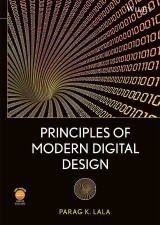Details

Principles of Modern Digital Design
1. Aufl.
|
138,99 € |
|
| Verlag: | Wiley |
| Format: | |
| Veröffentl.: | 10.09.2007 |
| ISBN/EAN: | 9780470125205 |
| Sprache: | englisch |
| Anzahl Seiten: | 448 |
DRM-geschütztes eBook, Sie benötigen z.B. Adobe Digital Editions und eine Adobe ID zum Lesen.
Beschreibungen
PRINCIPLES OF MODERN DIGITAL DESIGN <P>FROM UNDERLYING PRINCIPLES TO IMPLEMENTATION—A THOROUGH INTRODUCTION TO DIGITAL LOGIC DESIGN <p>With this book, readers discover the connection between logic design principles and theory and the logic design and optimization techniques used in practice. Therefore, they not only learn how to implement current design techniques, but also how these techniques were developed and why they work. With a deeper understanding of the underlying principles, readers become better problem-solvers when faced with new and difficult digital design challenges. <p><i>Principles of Modern Digital Design</i> begins with an examination of number systems and binary code followed by the fundamental concepts of digital logic. Next, readers advance to combinational logic design. Armed with this foundation, they are then introduced to VHDL, a powerful language used to describe the function of digital circuits and systems. <p>All the major topics needed for a thorough understanding of modern digital design are presented, including: <ul><li>Fundamentals of synchronous sequential circuits and synchronous sequential circuit design</li> <li>Combinational logic design using VHDL</li><li>Counter design</li><li>Sequential circuit design using VHDL</li><li>Asynchronous sequential circuits</li></ul> <p>VHDL-based logic design examples are provided throughout the book to illustrate both the underlying principles and practical design applications. Each chapter is followed by exercises that enable readers to put their skills into practice by solving realistic digital design problems. An accompanying website with Quartus II software enables readers to replicate the book’s examples and perform the exercises. <p>This book can be used for either a two- or one-semester course for undergraduate students in electrical and computer engineering and computer science. Its thorough explanation of theory, coupled with examples and exercises, enables both students and practitioners to master and implement modern digital design techniques with confidence.
1. Number Systems and Binary Codes. <p>2. Fundamental Concepts of Digital Logic.</p> <p>3. Combinational Logic Design.</p> <p>4. Fundamentals of Synchronous Sequential Circuits.</p> <p>5. VHDL in Digital Design.</p> <p>6. Combinational Logic Design using VHDL.</p> <p>7. Synchronous Sequential Circuit Design.</p> <p>8. Counter Design.</p> <p>9. Sequential Circuit Design using VHDL.</p> <p>10. Asynchronous Sequential Circuits.</p> <p>Appendix A. CMOS Logic.</p> <p>Index.</p>
<p><b>PARAG K. LALA, PHD, DSc(ENG),</b> is the Cary and Lois Patterson Chair of Electrical Engineering at Texas A&M University-Texarkana. Dr. Lala is the author of five books, including <i>Fault-Tolerant and Fault-Testable Hardware Design </i>and<i> Practical Digital Logic Design and Testing</i>. Dr. Lala was named a Fellow of the IEEE for “contributions to the development of self-checking logic and associated checker design.” He is also a Fellow of The Institution of Engineering and Technology, United Kingdom.</p>
<P>FROM UNDERLYING PRINCIPLES TO IMPLEMENTATION—A THOROUGH INTRODUCTION TO DIGITAL LOGIC DESIGN</P> <p>With this book, readers discover the connection between logic design principles and theory and the logic design and optimization techniques used in practice. Therefore, they not only learn how to implement current design techniques, but also how these techniques were developed and why they work. With a deeper understanding of the underlying principles, readers become better problem-solvers when faced with new and difficult digital design challenges. <p><i>Principles of Modern Digital Design</i> begins with an examination of number systems and binary code followed by the fundamental concepts of digital logic. Next, readers advance to combinational logic design. Armed with this foundation, they are then introduced to VHDL, a powerful language used to describe the function of digital circuits and systems. <p>All the major topics needed for a thorough understanding of modern digital design are presented, including: <ul><li>Fundamentals of synchronous sequential circuits and synchronous sequential circuit design</li> <li>Combinational logic design using VHDL</li><li>Counter design</li><li>Sequential circuit design using VHDL</li><li>Asynchronous sequential circuits</li></ul> <p>VHDL-based logic design examples are provided throughout the book to illustrate both the underlying principles and practical design applications. Each chapter is followed by exercises that enable readers to put their skills into practice by solving realistic digital design problems. An accompanying website with Quartus II software enables readers to replicate the book’s examples and perform the exercises. <p>This book can be used for either a two- or one-semester course for undergraduate students in electrical and computer engineering and computer science. Its thorough explanation of theory, coupled with examples and exercises, enables both students and practitioners to master and implement modern digital design techniques with confidence.


















